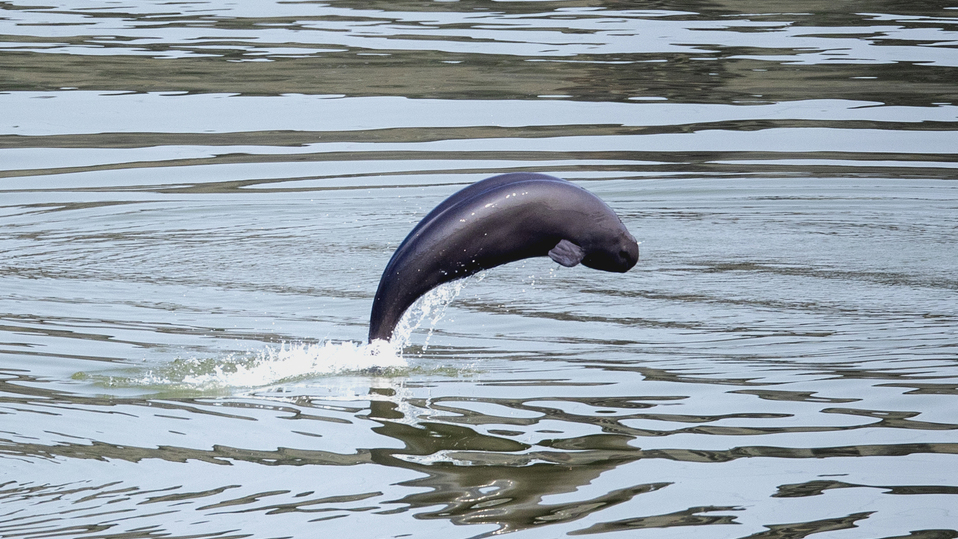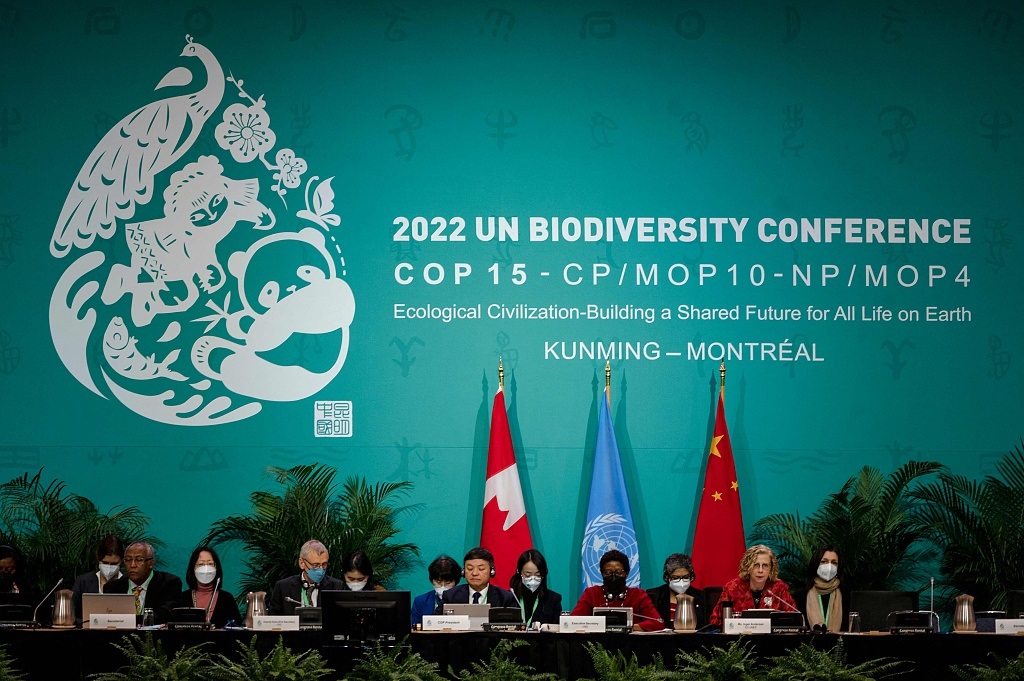

Hainan gibbon. /CFP
From less than 10 in 1980s to at least 36 nowadays, the growth of Hainan gibbon, the world's rarest primate and the most endangered among all gibbon species in the world, boosts the world's confidence in biodiversity protection.
"The protection of Hainan gibbons not only reflects China's active implementation of the UN Convention on Biological Diversity, but also shows the obvious results of China's actions in biodiversity conservation," said Zhang Xinsheng, former president of the International Union for Conservation of Nature (IUCN).
The slow but steady growth of Hainan gibbons in the Hainan Tropical Rainforest National Park also reflects China's determination and efforts in biodiversity protection in recent years.

A Yangtze finless porpoise jumps out of the water in the lower reaches of the Gezhouba Dam in Yichang City, central China's Hubei Province, November 9, 2022. /Xinhua
Chinese President Xi Jinping's report to the 20th National Congress of the Communist Party of China also stressed the importance of biodiversity protection in building a beautiful China and pursuing China's green development.
With the aim of enhancing diversity and sustainability in China's ecosystems, the report said: "We will develop the national park-based nature reserve system and carry out major biodiversity protection projects."
In the past decade, China has accelerated the development of national park-based nature reserve system. The Hainan Tropical Rainforest National Park was among the first batch of national parks established last year. The second batch of national parks is on the way.
At present, China has established nearly 10,000 nature reserves, accounting for around 18 percent of the nation's total landmass, said Ma Keping, the deputy director and secretary-general of the Biodiversity Committee of Chinese Academy of Sciences.
Meanwhile, China has taken the initiative to draw up ecological conservation red lines nationwide, covering zones that are critical to environmental function or are ecologically sensitive.
For example, the ecological conservation red lines drawn in areas including Qinghai-Tibet Plateau and Yangtze River Basin protect the vast majority of rare and endangered species and their habitats, according to the Ministry of Ecology and Environment.
Besides, China has also pushed for the integrated conservation and systematic restoration of mountains, rivers, forests, farmlands, lakes, grasslands and deserts in recent years. Thanks to the efforts, China's forest resources have increased by more than 70 million hectares in the past decade, ranking first in the world.

The second phase of the 15th Conference of the Parties to the United Nations Convention on Biodiversity kicked off in Montreal, Canada, December 7, 2022. /VCG
While steadily on its way in pursuing a beautiful China, the world's largest developing and most populated country also showed support for international efforts in biodiversity protection worldwide.
China was among the first to sign and ratify the Convention on Biological Diversity and it has fulfilled the obligations stipulated in the Convention.
In recent years, China has also cooperated with other countries on biodiversity protection and those cooperation has yielded fruitful results.
For example, the China-Laos cross-border Biodiversity Joint Conservation area has reached 200,000 hectares, effectively protecting rare and endangered species such as the Asian elephant and their habitats, according to the Ministry of Ecology and Environment.
Mentioning Kenya's Mombasa-Nairobi Railway, the Ministry of Ecology and Environment said the railway is equipped with large animal passages, bridges and culverts to ensure the free movement of wildlife.
There are still many more stories to be written on China's experiences and solutions in advancing global biodiversity protection.
At the second phase of the 15th Conference of the Parties to the United Nations Convention on Biodiversity (COP15),?which kicked off on December 7 in Canada, China remains as the president of the conference with the continued theme of "Ecological Civilization: Building a Shared Future for All Life on Earth."?
At the opening, Huang Runqiu, president of COP15 and China's minister of ecology and environment, called for international cooperation to achieve the "landmark outcome of the conference," the Post-2020 Global Biodiversity Framework, which aims to halt and reverse biodiversity losses by 2030.
The first phase of COP15 was held last October in Kunming, the capital of southwest China's Yunnan Province, at which Kunming Declaration was adopted, laying a solid political foundation for the second phase of COP15. (CGTN)

86-10-68597521 (day)
86-10-68597289 (night)

52 Sanlihe Rd., Xicheng District,
Beijing, China (100864)

